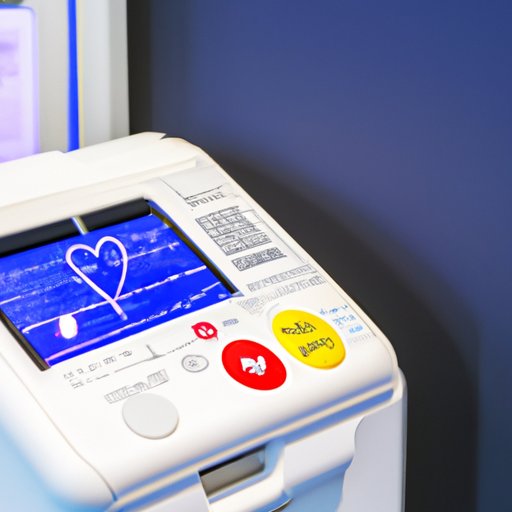Introduction
An automated external defibrillator (AED) is a portable medical device that can be used to provide lifesaving treatment for people suffering from sudden cardiac arrest (SCA). This article will explore the uses and features of an AED, as well as the steps involved in using one, in order to explain how it can be used to save lives in emergency situations.
How an Automated External Defibrillator (AED) Can Save Lives
AEDs are designed to be used by anyone, including those with no medical training, to provide life-saving treatment in the event of a cardiac arrest. When someone suffers from SCA, their heart stops beating normally and needs to be restarted with an electric shock, which is known as defibrillation. An AED is able to detect and analyze the heart rhythm and then deliver a shock if required. According to the American Heart Association, “For every minute that passes without defibrillation, the chance of survival decreases by 7 to 10 percent” (American Heart Association, 2020).
Having an AED available in a community can greatly improve the chances of survival for someone who suffers from SCA. AEDs can be found in many public places such as airports, shopping malls, and sports stadiums. They are also increasingly being carried by first responders and police officers, allowing them to provide lifesaving treatment in emergency situations. In addition, more and more schools and workplaces are now investing in AEDs to ensure they are prepared to respond quickly in the event of a cardiac emergency.
Having an AED in your community can also help to reduce the number of deaths due to SCA. According to a recent study, “the presence of an AED in a community increases the likelihood of surviving a cardiac arrest by up to 72%” (Vahdat et al., 2017).

Explaining the Uses and Features of an Automated External Defibrillator
An AED is a small, lightweight device that is easy to use in emergency situations. It consists of two main components: a battery pack and a set of electrodes. The electrodes are placed on the chest of the patient and connected to the AED via wires. The AED then analyzes the heart rhythm and delivers an electrical shock if required.
The AED is designed to be used by anyone, even those with no medical training. The device has clear instructions and voice prompts that guide the user through the process of using the AED. Most models also have a visual display that shows the user exactly where to place the electrodes and how much electrical energy to deliver.
In addition, many models of AEDs are equipped with advanced safety features such as self-tests and automatic shut-off functions. These safety features help to ensure that the device is functioning properly and that the electrical charge is not delivered unnecessarily.
Understanding the Steps Involved in Using an AED
When using an AED, it is important to follow the instructions carefully and take the necessary safety precautions. The first step is to call 911 or the local emergency services. Once the AED arrives, the user should open the device and turn it on. The user should then attach the electrodes to the patient’s chest and follow the voice prompts to deliver the electrical shock if needed.
It is important to note that AEDs are designed to be used in conjunction with cardiopulmonary resuscitation (CPR). CPR helps to keep oxygen circulating throughout the body while the AED is analyzing the heart’s rhythm. If the AED detects a shockable rhythm, it will prompt the user to stop CPR and allow the device to deliver the shock.
Once the shock has been delivered, it is important to resume CPR until the patient is stable. If the patient does not respond after three shocks, the user should contact emergency services and continue to provide CPR until help arrives.

An Overview of How AEDs Work and Their Advantages
AEDs work by delivering an electrical shock to the heart when it is in a state of ventricular fibrillation (VF). VF is a dangerous arrhythmia that prevents the heart from pumping blood effectively and can be fatal if left untreated. By delivering an electrical shock, the AED helps to restore the normal rhythm of the heart and allows it to pump blood effectively again.
The use of an AED has several advantages over manual defibrillation. For example, AEDs are easier to use and require less training than manual defibrillators. In addition, AEDs are able to detect and analyze the heart rhythm more quickly, which reduces the amount of time required to deliver the shock. Finally, AEDs are equipped with safety features that help to minimize the risk of delivering an unnecessary shock.
Conclusion
Automated external defibrillators (AEDs) are an invaluable tool for providing lifesaving treatment in the event of a cardiac arrest. They are easy to use and require minimal training, making them ideal for use in emergency situations. AEDs are able to detect and analyze the heart rhythm quickly, allowing them to deliver an electrical shock if needed. Having an AED in your community can greatly improve the chances of survival for someone who suffers from SCA.
In conclusion, it is clear that AEDs can be a vital tool for saving lives in emergency situations. By understanding the uses and features of an AED, as well as the steps involved in using one, we can ensure that we are prepared to respond quickly and appropriately in the event of a cardiac emergency.
(Note: Is this article not meeting your expectations? Do you have knowledge or insights to share? Unlock new opportunities and expand your reach by joining our authors team. Click Registration to join us and share your expertise with our readers.)
